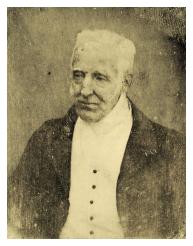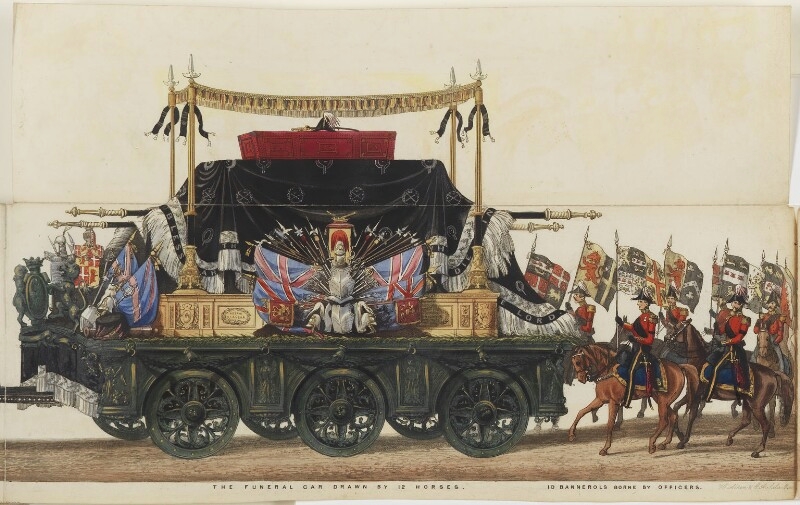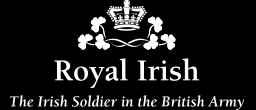Inniskillings attend The Duke of Wellington's funeral

|
| The Duke of Wellington, 1844. |
The Duke of Wellington’s State Funeral.
The Duke of Wellington KG GCB GCH PC FRS, Field Marshal and Commander-in-Chief of Her Majesty‘s Forces, died on 14 September 1852 aged 83. The only Waterloo veteran still serving at this time was the surgeon, Dr Mostyn. However, it was the then commanding officer of the 27th Inniskillings, Lieutenant Colonel A A Cunynghame and a detachment consisting of Captain Tounzel, Lieutenant Manly, one sergeant, one corporal and six privates, who represented the Inniskillings at the great pageant of Wellington’s Heraldic State Funeral in London on 18 November 1852. It was estimated that over one million spectators lined the route to watch the two-mile long procession passing from Horse Guards to St Paul‘s.
The detachment had various tasks both in the procession and at St Paul’s Cathedral:
At the front of the procession, led by Messenger of the College of Arms on foot, one Private represented the 27th Inniskillings in a marching body where every Regiment in Her Majesty’s service was represented by one of its soldiers.
The Commanding Officer bore the Duke’s Guidon in the procesion on horseback before handing it over to a bearer at the west door of St Paul’s. Lt Col Cunynghame then proceeded along the Nave to take his seat amongst over 10,000 attending the service.
 In the procession behind Wellington’s Funeral Car*, the Captain, Subaltern, Sergeant, Corporal and five Privates marched as a detachment in a formation led by the Deputy-Adjutant-General, Major General G A Wetherall, where every Regiment of the Service was represented by such a detachment. Wellington’s saddled horse with boots reversed in the stirrups, and led by the Duke’s groom, led this element of the procession. HM Queen Victoria is said to have wept at the sight of Wellington’s riderless horse. Throughout the funeral Prince Albert represented Victoria who witnessed the procession as it passed Buckingham Palace. Royal protocol directed that she was unable to attend a commoner‘s funeral.
In the procession behind Wellington’s Funeral Car*, the Captain, Subaltern, Sergeant, Corporal and five Privates marched as a detachment in a formation led by the Deputy-Adjutant-General, Major General G A Wetherall, where every Regiment of the Service was represented by such a detachment. Wellington’s saddled horse with boots reversed in the stirrups, and led by the Duke’s groom, led this element of the procession. HM Queen Victoria is said to have wept at the sight of Wellington’s riderless horse. Throughout the funeral Prince Albert represented Victoria who witnessed the procession as it passed Buckingham Palace. Royal protocol directed that she was unable to attend a commoner‘s funeral.
At St Paul’s, those on military duty in the procession moved into cathedral roles with one soldier moving to the foot of the steps at the west-door entrance, the remainder to the south side of the cathedral and the officers inside and along the Nave to their assigned places. The Regimental Colonel of the 27th Inniskillings, Lieutenant General Sir William Francis Patrick Napier KCB, was also present in St Paul’s where he sat in line near the bier having borne in procession from the steps and along the Nave to its assigned location, the Duke’s Bannerol Lineage of Wellesley and Pakenham.
Wellington’s sense of military punctuality would have been offended by the fact that the burial service in St Paul’s was delayed by almost an hour. This was due to a malfunction in the mechanism used to transfer his coffin from the ornate eighteen-ton funeral car to the bier at the cathedral’s west door. The committal began as the coffin was lowered through the floor under the Whispering Gallery into the burial crypt to the solemn strains of Handel’s ‘Dead March’ from ‘Saul’. At the end of the burial service, Garter Principal King of Arms, Sir Charles George Young concluded the service by listing Wellington’s domestic and foreign titles and tributes in a farewell proclamation:
'Thus it has pleased Almighty God to take out of this transitory life onto His Divine Mercy, the late Most High, Mighty, and Most Noble Prince,
Arthur, Duke and Marquess of Wellington,
Marquess Douro, Earl of Wellington,
Viscount Wellington and Baron Douro,
Knight of the Most Noble Order of the Garter,
Knight Grand Cross of The Most Honourable Order of the Bath,
One of Her Majesty’s Most Honourable Privy Council, and
Field Marshal and Commander-in-Chief of Her Majesty's Forces.
Field Marshal of the Austrian Army,
Field Marshal of the Hanoverian Army,
Field Marshal of the Army of the Netherlands,
Marshal-General of the Portuguese Army,
Field Marshal of the Prussian Army,
Field Marshal of the Russian Army,
and
Captain-General of the Spanish Army.
Prince of Waterloo, of the Kingdom of the Netherlands, Duke of Ciudad Rodrigo
and Grandee of Spain of the First Class.
Duke of Victoria, Marquess of Torres Vedras, and Count of Vimiera in Portugal.
Knight of the Most Illustrious Order of the Golden Fleece, and of the Military Orders
of St. Ferdinand and of St. Hermenigilde of Spain.
Knight Grand Cross of the Orders of the Black Eagle and of the Red Eagle of Prussia.
Knight Grand Cross of the Imperial Military Order of Maria Teresa of Austria.
Knight of the Imperial Orders of St. Andrew, St. Alexander Newski, and St. George of Russia.
Knight Grand Cross of the Royal Portuguese Military Order of the Tower and Sword.
Knight Grand Cross of the Royal and Military Order of the Sword of Sweden.
Knight of the Order of St. Esprit of France.
Knight of the Order of the Elephant of Denmark.
Knight Grand Cross of the Royal Hanoverian Guelphic Order.
Knight of the Order of St. Januarius and of the Military Order of St. Ferdinand and
of Merit of the Two Sicilies.
Knight Grand Cross of the Supreme Order of the Annunciation of Sardinia.
Knight Grand Cross of the Royal Military Order of Maximilian Joseph of Bavaria.
Knight of the Royal Order of the Rue Crown of Saxony,
Knight Grand Cross of the Order of Military Merit of Wurtemberg.
Knight Grand Cross of the Military Order of William of the Netherlands.
Knight of the Order of the Golden Lion of Hesse Cassel,
and
Knight Grand Cross of the Orders of Fidelity and of the Lion of Baden.'
It was fitting that the 27th (Inniskilling) Regiment of Foot, which saved 'Old Nosey's' centre at Waterloo until 'lying dead as a square', should join the nation in this farewell to the greatest Anglo-Irish general, statesman, victor of Waterloo and twice former prime minister.
*
Image used by Creative Commons Licencing from the National Portrait Gallery





